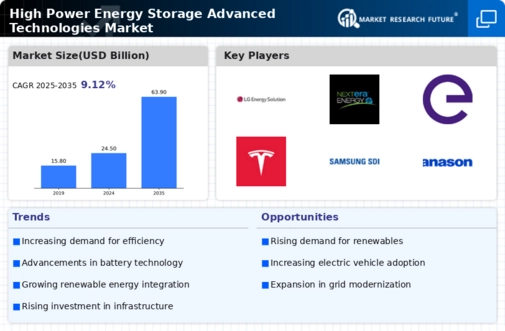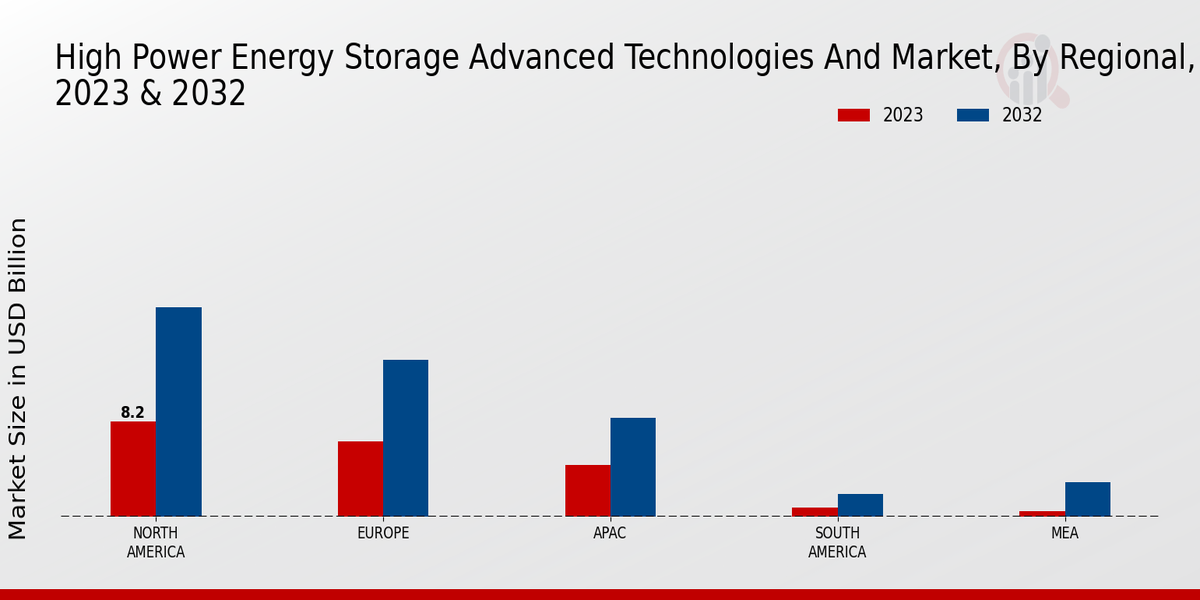Market Growth Projections
The Global High Power Energy Storage Advanced Technologies Market Industry is poised for substantial growth, with projections indicating a market size of 24.5 USD Billion in 2024 and an anticipated increase to 63.9 USD Billion by 2035. This growth trajectory reflects a compound annual growth rate (CAGR) of 9.12% from 2025 to 2035. The expansion of the market is driven by various factors, including technological advancements, government policies, and the increasing demand for renewable energy integration. As the energy landscape evolves, the role of advanced energy storage technologies becomes increasingly vital in supporting sustainable energy systems.
Rising Electric Vehicle Adoption
The surge in electric vehicle (EV) adoption is a key driver of the Global High Power Energy Storage Advanced Technologies Market Industry. As the automotive sector transitions towards electrification, the demand for high-capacity batteries increases. Energy storage technologies are crucial for powering EVs and supporting charging infrastructure. This growing market segment not only boosts battery production but also stimulates advancements in energy storage technologies. The interplay between the EV market and energy storage is expected to contribute significantly to the overall market growth, with projections indicating a robust expansion in the coming years.
Government Policies and Incentives
Government policies and incentives significantly influence the Global High Power Energy Storage Advanced Technologies Market Industry. Many governments worldwide are implementing supportive regulations and financial incentives to promote energy storage deployment. For instance, tax credits, grants, and subsidies for energy storage projects encourage investment and innovation. Such policies are essential for achieving national energy security and sustainability goals. As a result, the market is expected to grow to 63.9 USD Billion by 2035, driven by favorable regulatory frameworks that facilitate the adoption of advanced energy storage technologies.
Growing Demand for Renewable Energy Integration
The increasing global emphasis on renewable energy sources drives the Global High Power Energy Storage Advanced Technologies Market Industry. As countries strive to meet climate goals, the integration of renewable energy, such as solar and wind, necessitates robust energy storage solutions. Energy storage technologies, including lithium-ion batteries and flow batteries, are essential for balancing supply and demand. In 2024, the market is projected to reach 24.5 USD Billion, reflecting the urgent need for efficient energy storage systems that can accommodate the intermittent nature of renewable energy generation. This trend is expected to continue, with the market potentially expanding significantly by 2035.
Increasing Need for Grid Stability and Resilience
The need for grid stability and resilience is becoming increasingly critical, thereby influencing the Global High Power Energy Storage Advanced Technologies Market Industry. As energy systems face challenges from extreme weather events and fluctuating demand, energy storage solutions provide essential support for grid management. Technologies such as pumped hydro storage and battery energy storage systems enhance grid reliability and enable the integration of diverse energy sources. This growing focus on grid resilience is likely to propel market growth, as utilities and energy providers invest in advanced storage solutions to ensure a stable energy supply.
Technological Advancements in Energy Storage Solutions
Technological innovations play a pivotal role in shaping the Global High Power Energy Storage Advanced Technologies Market Industry. Developments in battery chemistry, such as solid-state batteries and advanced lithium-ion technologies, enhance energy density and safety. These advancements not only improve performance but also reduce costs, making energy storage more accessible. As a result, the market is anticipated to grow at a CAGR of 9.12% from 2025 to 2035. This growth trajectory indicates a strong future for energy storage technologies, which are increasingly viewed as critical components of modern energy systems.














